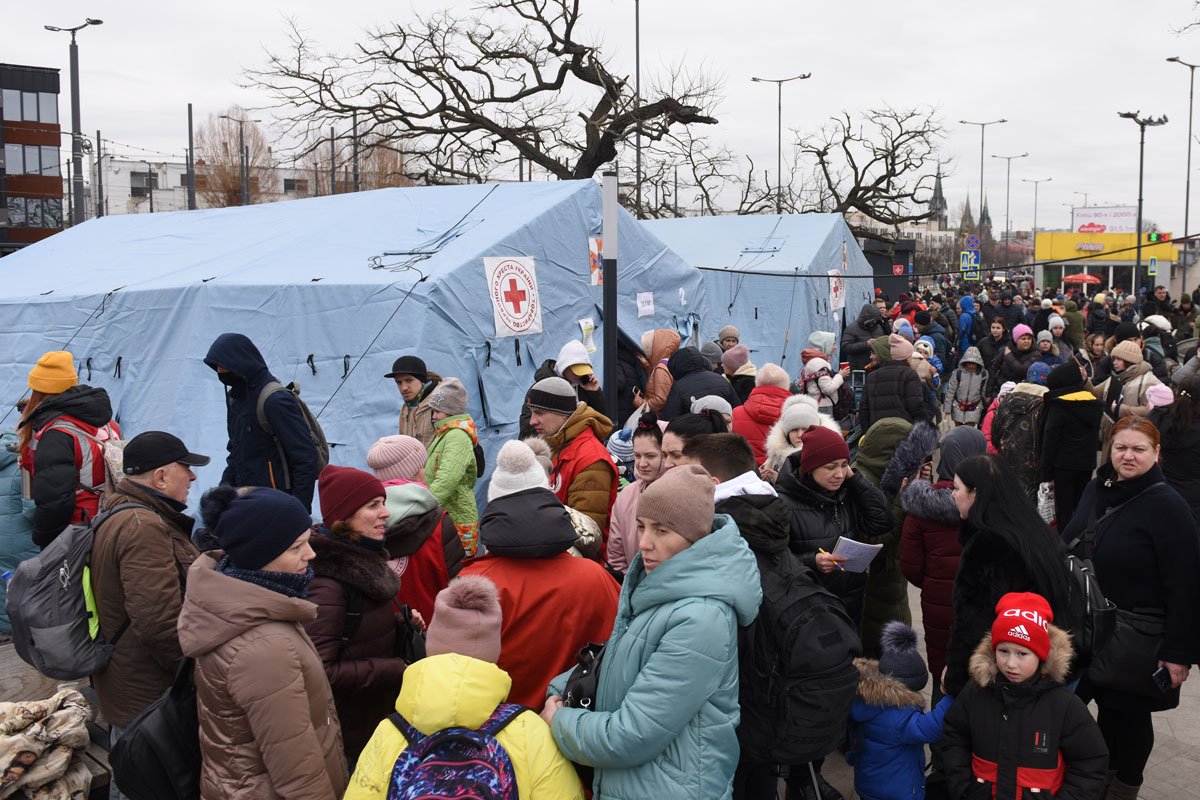What the funding response to the crisis in Ukraine tells us about the state of crisis financing
by Michèle Plichta, Research Assistant
Credit: Shutterstock
The war in Ukraine has led to an estimated 24 million people in urgent need of humanitarian assistance. Nearly 6 million refugees have fled Ukraine and close to 8 million people have been displaced within the country. Infrastructure has been devastated. This conflict comes at a time when humanitarian needs across the globe for 2022 were already projected at the highest level in decades, further stretching an international crisis financing system challenged by the unprecedented impacts of the covid-19 pandemic. This blog reflects on the international crisis financing response to the Ukraine crisis to date, and what this tells us about the state of how the world pays for disasters.
The role of international financial institutions
The remarkable size and speed of the initial financing response to the crisis surfaces interesting insights into where the bulk of the funding is from. As early as 1 March 2022 – less than a week after the start of the war on 24 February – the World Bank pledged 3 billion USD, while the IMF made 1.4 billion USD available through its Rapid Financing Instrument (RFI) and announced an additional 2.2 billion USD under Ukraine’s Stand-By Arrangement to be made available before the end of June.
As shown in Figure 1, regional European development banks announced substantial packages of support within weeks, with the European Investment Bank (EIB)’s pledging 4 billion EUR (~4.3 billion USD). The sums pledged by International Financial Institutions (IFIs) have so far dwarfed funding for the humanitarian response through UN-coordinated appeals.[1]
Figure 1: Funding announcements (in USD million)
Note: Funding announcements are taken from press releases and published documents by the institutions. These initial announcements are pledged amounts rather than committed amounts for which a budget has been made available. For announcements in EUR – by the EIB, EBRD and CEB – the 12 April 2022 EUR to USD exchange rate has been used to convert the amounts.
These pledges demonstrate the major role IFIs are now playing in responding to crises, both multilateral development banks (MDBs) and regional development banks (RDBs). As is often the case for development banks, most of this support comes in the form of loans provided to the Ukraine government, or to Ukrainian companies in the case of the European Bank for Reconstruction and Development (EBRD). The MDBs are also playing a mobilising and coordinating role for bilateral donor contributions to development support, notably mobilising bilateral guarantees and creating a multi-donor trust fund.
However, the speed with which funding is announced doesn’t always translate into the speed with which that funding is available to reach where it is needed most. The IMF confirmed the disbursement of its RFI funding by 9 March. The World Bank’s pledge of 3 billion USD, however, was followed by a request for approval to shift 1 billion USD from the recent cycle of its International Development Association (IDA19), the World Bank’s fund for the poorest countries. This suggests it may face challenges accessing timely funds for rapid dispersal and there may be room to improve capabilities and preparedness to respond to crises effectively.
While the initial response has been strong, there will be further challenges ahead for the IFIs. Ukraine is likely to continue to need sustained financial support to maintain basic government functions and to address other challenges such as the impacts of long-term disruptions to education and livelihoods, the continued displacement of people and the substantial reconstruction needs. Given the typically protracted nature of such conflicts, IFIs will need to think on how they engage strategically and sustainably over time. Heavy reliance on loans may become difficult to sustain for Ukrainian public authorities weakened by conflict when moving into post-crisis recovery.
Significant private donations
Figure 2 shows the significant role of private sector donations in the Ukraine response: cash and in-kind donations made by private sector entities (corporations and corporate-affiliated foundations) add up to 1.1 billion USD, of which 334 million USD has been paid already (data between 24 February and 26 April). In addition to this, donations from private individuals are another important source of crisis response funding but also in-kind assistance. While these contributions are largely untracked, the 260 million GBP to the UK Disasters Emergency Committee (DEC) Ukraine appeal indicate they are likely to be significant.
Figure 2: Recipients of private sector donations (in USD million)
Note: Data is taken from the Ukraine Private Sector Donations Tracker (26 April 2022 update) by the OCHA/UNDP Connecting Business initiative (CBi).
Discrepancy in appeals coverage
The UN-coordinated appeals system launched a major funding appeal on 1 March including a Ukraine Flash Appeal of 1.1 billion USD to meet the humanitarian needs of civilians inside Ukraine, and a Ukraine Regional Refugee Response Plan (RRP) of 551 million USD to support those who have fled to neighbouring countries. These requirements were revised upwards on 25 April with the new amounts being 2.3 billion USD and 1.9 billion USD respectively. Against the revised targets, Financial Tracking Service data in Figure 3 show that by 1 May there was a relatively high level of coverage of the Ukraine Flash Appeal and RRP – 45% and 16%, in sharp contrast with just 6% coverage of funding needs on average for other ongoing crises in 2022.
Figure 3: 2022 UN appeals and response plans coverage
This discrepancy in appeal coverage and large unmet requirements is indicative of the continued challenges the international crisis financing system faces, including the imbalance in responding to protracted crises and accommodating spikes in demand due to sudden-onset crises, which can generate competition, unpredictability, and inequity of funding response across crises.
Pre-arranging financing can help the international crisis financing system be better prepared
When taken individually, major crises like the one generated by the conflict in Ukraine may be difficult to predict. But the international crisis response system understands that responding to large-scale, complex crises is now part of routine business – so much so that the category of Level 3 (L3) crises and a set of protocols were introduced to recognise the challenge these shocks present to the crisis response system. The financing response, however, continues to rely on the traditional ‘begging bowl’ approach of issuing ex-post funding appeals.
The Centre for Disaster Protection has argued previously that the way we pay for disasters needs to change. Pre-arranging financing for predictable risks can help ensure responses to urgent and unforeseen crises don’t diminish financing for existing needs, within a system already stretched. It can help lead to greater predictability and timeliness of funding, leaving space for discretionary responses to crises much harder to predict.
The Ukraine crisis offers a sobering example which highlights the urgency with which the international crisis financing system must upgrade its financing toolbox to accommodate major peaks in demand.
[1] The amount included for the UN is the total size of the appeals launched on 1 March 2022. This is different from the other funding announcements, as it does not reflect the funding that has been pledged or committed by a range of institutional and private donors. Figure 3 includes information about the coverage of these initial appeals as well as the revised appeals.




